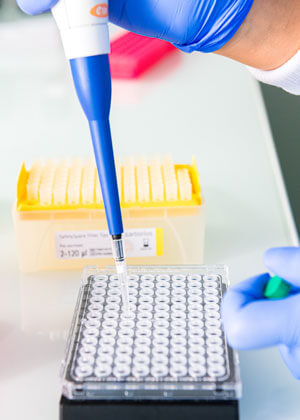Our tests
Agrivalys 71 performs immunology, parasitology, bacteriology and molecular biology tests on cattle, sheep, goats, pigs, poultry and plants.
Our laboratory specialises in animal and plant health tests :
We are called in for :
Regulated or non-regulated diseases, subject to official controls carried out as part of exporting live animals depending on the health certificate requirements of the importing country.
Diseases not subject to mandatory tests but for which livestock farmers may wish to carry out regular checks on a voluntary basis (should they suspect an infection for example).
Diseases diagnosed by a vet.
Regulated or non-regulated diseases, controlled as part of departmental epidemio-surveillance and health monitoring, in partnership with the national SAGIR network.
Whether you are interested in our animal or plant health hub, the process is as follows :
With ELISA (Enzyme-Linked Immunosorbent Assay) methods we can detect antibodies, antigens and haptens using samples from animals or plants.
The tests are carried out using reagent kits provided by various suppliers.
The specific features of each ELISA method are detailed in the protocols accompanying the commercial kits.
The intensity of the final colouration is measured using a spectrophotometer. This colouration is a direct (indirect ELISA) or inverse (competitive ELISA) function of the concentration of the specific substance tested present in the sample.
Fields of application :
Depending on the method, tests can be carried out on whole blood, single serums or pooled sera, plasma, milk or plant extracts (leaves, wood, roots and pseudostems etc.). This can be done manually or using automated systems.
The tests are carried out either to perform an individual diagnosis, or as part of voluntary or compulsory prophylaxis, or as part of official testing.
PCR (Polymerase Chain Reaction) uses the DNA polymerase enzyme to make it possible to amplify a specific region of a given nucleic acid, so as to obtain a sufficient quantity of it to detect and analyse it.
The replication of a double-stranded DNA extract is achieved by repeating a series of reactions over and over again. This means that during the PCR reaction the products obtained at the end of each cycle serve as a template for the following cycle, the amplification is therefore exponential from the very beginning.
PCR occurs in 3 steps :PCR means we are able to detect amplicons (fragments of DNA generated by PCR) in real time through the emission of a fluorescent signal proportional to the quantity of amplicons generated.
In the laboratory, we use TaqMan® probes to monitor the amplification reaction. These are marked with different fluorophores (FAM, VIC, NED and CY5 etc.) so as to detect several valances (multiplex PCR).
For RNA genomes, RT (Reverse Transcription) has to be carried out as a preliminary step. This involves taking an RNA template and synthesising complementary DNA from it. This can then be used as a template for the PCR. This reaction is catalysed by Reverse Transcriptase enzymes.
It may be necessary to first carry out a (DNA double-strand) denaturation step.
The PCR technique is based on direct evidence of genetic material of pathogen micro-organisms, in other words either DNA (Chlamydophila, Coxiella, Pasteurella and Mycoplasma etc.) or RNA (BTV or BVD viruses or respiratory viruses) gathered from “acellular” samples (total blood, serum, plasma and cell culture supernatants) or “cellular” ones (milk, organs, swabs, transtracheal aspiration liquid, breeding grounds and faeces).
It can be qualitative, relative to a material at the interpretation threshold or quantitative.






